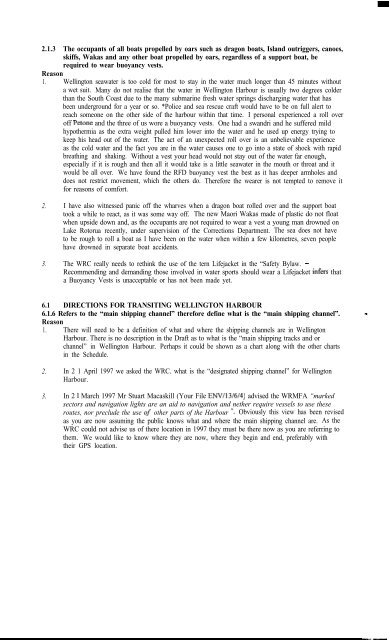Attach 4 (PDF) - Greater Wellington Regional Council
Attach 4 (PDF) - Greater Wellington Regional Council
Attach 4 (PDF) - Greater Wellington Regional Council
You also want an ePaper? Increase the reach of your titles
YUMPU automatically turns print PDFs into web optimized ePapers that Google loves.
2.1.3 The occupants of all boats propelled by oars such as dragon boats, Island outriggers, canoes,<br />
skiffs, Wakas and any other boat propelled by oars, regardless of a support boat, be<br />
required to wear buoyancy vests.<br />
Reason<br />
1. <strong>Wellington</strong> seawater is too cold for most to stay in the water much longer than 45 minutes without<br />
a wet suit. Many do not realise that the water in <strong>Wellington</strong> Harbour is usually two degrees colder<br />
than the South Coast due to the many submarine fresh water springs discharging water that has<br />
been underground for a year or so. *Police and sea rescue craft would have to be on full alert to<br />
reach someone on the other side of the harbour within that time. I personal experienced a roll over<br />
off Petone and the three of us wore a buoyancy vests. One had a swandri and he suffered mild<br />
hypothermia as the extra weight pulled him lower into the water and he used up energy trying to<br />
keep his head out of the water. The act of an unexpected roll over is an unbelievable experience<br />
as the cold water and the fact you are in the water causes one to go into a state of shock with rapid<br />
breathing and shaking. Without a vest your head would not stay out of the water far enough,<br />
especially if it is rough and then all it would take is a little seawater in the mouth or throat and it<br />
would be all over. We have found the RFD buoyancy vest the best as it has deeper armholes and<br />
does not restrict movement, which the others do. Therefore the wearer is not tempted to remove it<br />
for reasons of comfort.<br />
2. I have also witnessed panic off the wharves when a dragon boat rolled over and the support boat<br />
took a while to react, as it was some way off. The new Maori Wakas made of plastic do not float<br />
when upside down and, as the occupants are not required to wear a vest a young man drowned on<br />
Lake Rotorua recently, under supervision of the Corrections Department. The sea does not have<br />
to be rough to roll a boat as I have been on the water when within a few kilometres, seven people<br />
have drowned in separate boat accidents.<br />
3. The WRC really needs to rethink the use of the tern Lifejacket in the “Safety Bylaw. -<br />
Recommending and demanding those involved in water sports should wear a Lifejacket infers that<br />
a Buoyancy Vests is unacceptable or has not been made yet.<br />
6.1 DIRECTIONS FOR TRANSITING WELLINGTON HARBOUR<br />
6.1.6 Refers to the “main shipping channel” therefore define what is the “main shipping channel”.<br />
Reason<br />
1. There will need to be a definition of what and where the shipping channels are in <strong>Wellington</strong><br />
Harbour. There is no description in the Draft as to what is the “main shipping tracks and or<br />
channel” in <strong>Wellington</strong> Harbour. Perhaps it could be shown as a chart along with the other charts<br />
in the Schedule.<br />
2. In 2 1 April 1997 we asked the WRC. what is the “designated shipping channel” for <strong>Wellington</strong><br />
Harbour.<br />
3. In 2 1 March 1997 Mr Stuart Macaskill (Your File ENV/13/6/4) advised the WRMFA “marked<br />
sectors and navigation lights are an aid to navigation and nether require vessels to use these<br />
routes, nor preclude the use qf other parts of the Harbour “. Obviously this view has been revised<br />
as you are now assuming the public knows what and where the main shipping channel are. As the<br />
WRC could not advise us of there location in 1997 they must be there now as you are referring to<br />
them. We would like to know where they are now, where they begin and end, preferably with<br />
their GPS location.
















